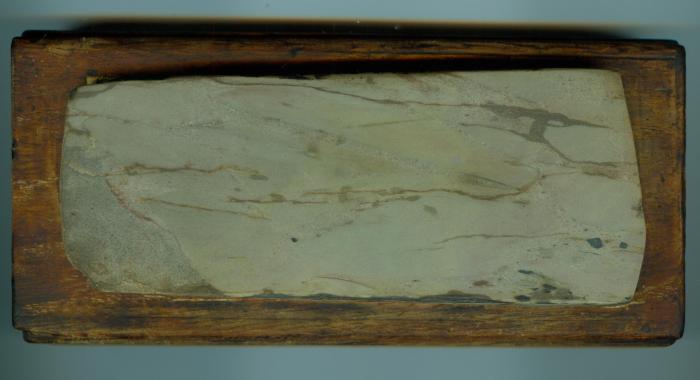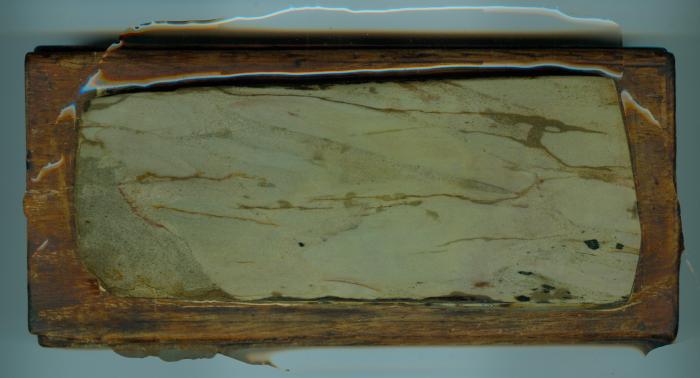Results 1 to 10 of 23
Thread: Is this a Charnley Forest?
-
03-09-2009, 11:30 PM #1
-
03-09-2009, 11:47 PM #2

I've seen Charnleys that loo0ked white in photos but in actuality they are a light olive green. Some have magenta streaking in them. If ther stone is an olive green it might be a Charnley.
 Be careful how you treat people on your way up, you may meet them again on your way back down.
Be careful how you treat people on your way up, you may meet them again on your way back down.
-
The Following User Says Thank You to JimmyHAD For This Useful Post:
Oldengaerde (03-12-2009)
-
03-10-2009, 12:13 PM #3Senior Member



- Join Date
- Apr 2008
- Location
- Essex, UK
- Posts
- 3,816
Thanked: 3164
It certainly looks like one, but it also looks a lot like some vintage coticules, especially with those black spots that manganese produces in coticules. Some Charnley Forest hones are said to have hard deposits in them that make them unsuitable for honing, which is why the Whittle Hill quarry produced the best stone in the region - inclusion free.
Regards,
Neil
-
The Following User Says Thank You to Neil Miller For This Useful Post:
Oldengaerde (03-12-2009)
-
03-12-2009, 01:48 AM #4

I'm certain it isn't a coticule. It's too hard, there are no layers visible on the flanks as there are on hard green coticules, and I can find no trace of spessartine.
It does have the particular Charnley Forest mossy green complexion. There are patches with diffuse purplish hints, and there is a purple vein too (difficult to see in the pictures, but the leftmost queer one).
I read about non-Whittle Hill stones having (hard) inclusions and being stingy, but I don't know what form the inclusions take. It's the first time I see inclusions of this kind in a CF-like stone: as if crevices have been filled with fine hour-glass sand of matching colours and an occasional small black pebble.
In want of alternatives, my best guess would still be it's a CF, but hone afficionado hi_bud_gl had some interesting contrariant observations. CF, he reasons, is a very hard and very slow-cutting hone. Therefore most of them were cut oblong in lenghts above 8", usually even 10"-13", otherwise honing would have been far too weary. A CF of only 5", like this one, wouldn't make sense. Therefore it most likely is something else.
- but what?
-
03-12-2009, 02:16 AM #5

Give it a go with a razor or two and if it doesn't work for them perhaps a knife blade. Whatever it may be if it is effective that is the important thing. The ideal situation is that you would find that it is the greatest razor hone yet known to man. Then you would be the only one in the world with one, no one would know what it is, and hi_bud and I would be pulling our hair out.

 Be careful how you treat people on your way up, you may meet them again on your way back down.
Be careful how you treat people on your way up, you may meet them again on your way back down.
-
03-12-2009, 10:32 AM #6

Actually, I think it is! Now you and hi_bus_gl can start competing for my favour. Let me think what I'd like...
Heavens, was that a pig flying past the window?

-
03-12-2009, 02:06 PM #7
 cf
cf
h;mmmmmmmmmm interesting
is this guy pulling our legs Jimmy?
Lets be strong not to fall his ........../
Darn I want test that stone?
Problem is this .This person is overseas that kills me or i would say send it to me and let me try.
Now lets get serious.
Jimmy is right try it out.the easiest way to figure it out .
at first lap the stone you will feel it feels like a glass after lapping.
Then make a slurry use dmt or hardest stone you have.Use slurry from it not another slurry stone.
Then hone the blade.check it under miscroscope.
Edge wont be as shiny as come of from norton 8 but will be finer.(all this done with water)
after this
try same blade with oil edge will be wonderful
Lastly lETS HOPE THIS STONE WON'T BE MISTAKE MADE " CLUED TO THE BASE UPSIDE DOWN."
-
The Following User Says Thank You to hi_bud_gl For This Useful Post:
Oldengaerde (03-12-2009)
-
03-12-2009, 02:35 PM #8Senior Member



- Join Date
- Apr 2008
- Location
- Essex, UK
- Posts
- 3,816
Thanked: 3164
From what I've read, the stones that didn't come from the Whittle Hill quarry tended to be mostly olive green in colour and given to inclusions - they are said to be a recrystallised form of chert (flinty stuff) of which the novaculites like arkansas stones are formed. One reference cited that darker areas going towards purple were not desirable, as a lot of the faults were found in the dark areas.
The size is a bit odd to me. Mostreferences I've seen say that the stone is so slow that it was usually cut a lot larger than the usual hones, say 250mm or more, so you got more out of it on each stroke.
Regards,
Neil
-
The Following User Says Thank You to Neil Miller For This Useful Post:
Oldengaerde (03-12-2009)
-
03-12-2009, 04:02 PM #9
-
03-12-2009, 05:26 PM #10Senior Member



- Join Date
- Apr 2008
- Location
- Essex, UK
- Posts
- 3,816
Thanked: 3164
Jimmy - it said that the best ones tended towards a greyish colour (it didn't say that there were not olive coloured ones), that they had red spots and swirls and that the ones from the lesser quarries were decidely green and had inclusions. A lot of it was crushed and used as roadstone. The ones with large dark areas appear to had have softer veins with hard bits in the veins.
Regards,
Neil


 3Likes
3Likes LinkBack URL
LinkBack URL About LinkBacks
About LinkBacks








 Reply With Quote
Reply With Quote
